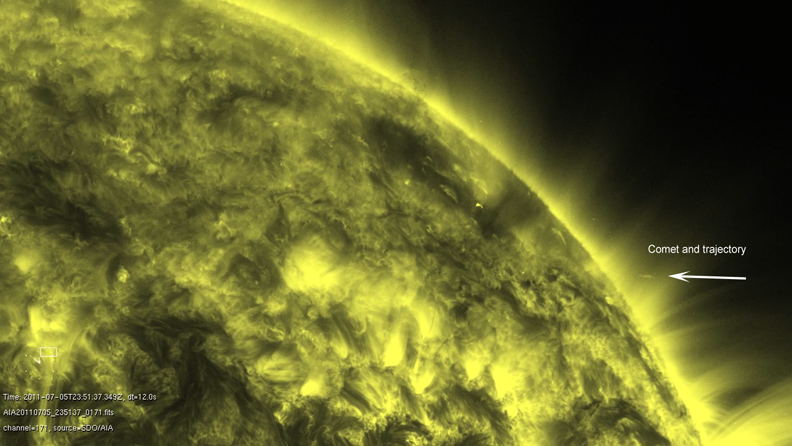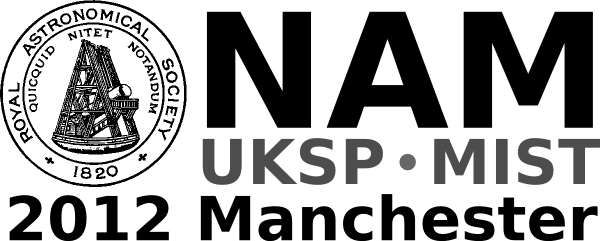UK-Germany National Astronomy Meeting NAM2012
Supersonic snowballs in hell: how comets fizzle out or survive a flight through the Sun's atmosphere
Royal Astronomical Society press release
RAS PR 12/26, NAM 17
Friday 30 March 2012

The Solar Dynamics Observatory AIA imager (observing in extreme ultraviolet light) observed the evaporation of a sun-grazing comet as it disintegrated over about a 15-minute period (July 6, 2011), and seeing the material interact with the corona of the Sun, both events never observed before.
Since the 1980s astronomers have seen thousands of comets falling towards the Sun, most of them too small to survive a close approach, let alone to re-emerge. Until recently no such objects had been seen very close to the Sun as the glare of sunlight made them impossible to observe. Now a team of scientists led by Professor Emeritus John Brown, Astronomer Royal for Scotland and former Regius Professor of Astronomy at Glasgow University, have worked out which comets make it through this fiery journey, which fizzle out high up and which explode just above the surface. Prof. Brown will present this new work in a paper at the National Astronomy Meeting in Manchester on Friday 30 March.
Comets are giant dusty snowballs believed to date from the epoch of the formation of the Sun and planets, so carry important information about the early history and composition of the Solar system. The comets we see spend most of their time very far from the Sun, orbiting in the so called Oort Cloud, before being disrupted into orbits that carry them towards our nearest star over tens of thousands of years.
When comets reach the inner Solar System, their dusty ices melt and vaporise to form huge tails blown back by the solar wind and by sunlight. The largest, like the famous Comet Hale Bopp seen in the late 1990s, have nuclei tens of kilometres across and masses of 10 million million tonnes. Objects this large only lose a tiny fraction of their material on each passage around the Sun, so are able to survive thousands of journeys through the Solar System. In contrast, the smallest objects may only be 10 metres across with a mass of 1000 tonnes. If these small comets make a close approach to the Sun, they are vaporised by sunlight and by the friction of the atmospheric gas.
In the culmination of work carried out over the last few years, Professor Brown and his colleagues are now able to predict how comets lose their mass and are destroyed in the solar atmosphere, their behaviour depending on whether or not their orbital path reaches into the 'lower atmosphere' 7000 km (roughly 1% of the solar radius) from the top of the brightest visible solar layer, the photosphere. The team worked out the different ways comets give up their mass, momentum and energy to the Sun's atmosphere according to their height. Above 7000 km the cometary nuclei are slowly vaporised by sunlight and the gases streaming off into the coma and tail lose energy and momentum by atmospheric drag. In the low solar atmosphere material is stripped away not by sunlight but by the drag of the solar gas surrounding the comet and by exploding under the 'ram pressure' force of the atmosphere as the comet runs into denser layers.
The group found that sunskimmer comets (those with their closest approach more than 7000 km from the Sun) are destroyed in a slow 'fizzle' lasting hundreds to thousands of seconds, depending on their mass. During their demise they should emit weak but detectable extreme ultraviolet (XUV) radiation. In contrast, the 'sunplungers' that approach the Sun more closely will be destroyed in a few seconds as they crash into the dense layers of the lower solar atmosphere. The resulting explosions produce effects similar to those of solar flares, such as sunquakes on the Sun's surface. Finally, if the most massive comets were to collide with the Sun they would produce dramatic explosions just above the photosphere itself.
In July and December last year the NASA Solar Dynamics Observatory (SDO) satellite made the first direct observations of comets making close approaches to the Sun. The first comet, C / 2011 N3 (SOHO) was completely destroyed after passing 100,000 km above the photosphere whilst the second and larger comet, C / 2011 W3 (Lovejoy) survived a close approach to a similar distance (140,000 km) although it lost a significant fraction of its mass in the process. Both events were in line with the predictions of Prof. Brown and his collaborators. They emphasise that, contrary to some news releases, the death or attrition of such comets has nothing to do with the high temperature (two million degrees Celsius) of the outer solar atmosphere since, though hot, it is so tenuous that it contains little heat.
Prof. Brown comments: "In modelling how icy comets behave in this extreme environment, we really are starting to understand what happens to these 'supersonic snowballs in hell' when they make a close approach to the Sun.
'The two sun skimmers seen last year have already given us a new insight into the Sun's atmosphere and it's only a matter of time before we see the flare from a sun plunger - with a low enough orbit to reach the lower atmosphere of the Sun. When that happens we will be able to analyse the light from the resulting 'cometary flare' and find out even more about the composition of the interiors of comets."
IMAGES AND CAPTIONS
Images and movies of the close approach of Comet C 2011 / W3 (Lovejoy) can be seen at http://science.nasa.gov/science-news/science-at-nasa/2011/16dec_cometlovejoy/
Images and movies of the close approach and demise of Comet C 2011 / N3 (SOHO) can be seen at http://sdo.gsfc.nasa.gov/gallery/potw.php?v=item&id=58
MEDIA CONTACTS
NAM 2012 Press Office (0900 - 1730 BST, 27-29 March; 0900 - 1630 BST 30 March)
Room 3.214
University Place building
University of Manchester
Manchester
UK
Tel: +44 (0)161 306 7313
Dr Robert Massey
Royal Astronomical Society
Mob: +44 (0)794 124 8035
Email: rm@ras.org.uk
Anita Heward
Royal Astronomical Society
Mob: +44 (0)7756 034 243
Email: anitaheward@btinternet.com
Dr Klaus Jaeger
Pressereferent / Press Officer im Vorstand der Astronomischen Gesellschaft
Tel: +49 6221 528 379
Email: pressereferent@astronomische-gesellschaft.de
Dan Cochlin
Media Officer (Faculty of Engineering and Physical Sciences)
University of Manchester
Tel: +44 (0)161 275 8387
Email: daniel.cochlin@manchester.ac.uk
SCIENCE CONTACTS
Prof. John Brown
Emeritus Professor of Astronomy and Astronomer Royal for Scotland
Glasgow University
Scotland
Tel: +44 (0)141 330 5182
Email: john.brown@glasgow.ac.uk
NOTES FOR EDITORS
NAM 2012
Bringing together more than 900 astronomers and space scientists, the National Astronomy Meeting (NAM 2012) will take place from 27-30 March 2012 in the University Place conference centre at the University of Manchester in the UK. The conference is a joint meeting of the Royal Astronomical Society (RAS) and the German Astronomische Gesellschaft (AG) and is held in conjunction with the UK Solar Physics (UKSP: www.uksolphys.org) and Magnetosphere Ionosphere Solar Terrestrial (MIST: www.mist.ac.uk) meetings. NAM 2012 is principally sponsored by the RAS, AG, STFC and the University of Manchester.
The Royal Astronomical Society
The Royal Astronomical Society (RAS: www.ras.org.uk), founded in 1820, encourages and promotes the study of astronomy, solar-system science, geophysics and closely related branches of science. The RAS organises scientific meetings, publishes international research and review journals, recognizes outstanding achievements by the award of medals and prizes, maintains an extensive library, supports education through grants and outreach activities and represents UK astronomy nationally and internationally. Its more than 3500 members (Fellows), a third based overseas, include scientific researchers in universities, observatories and laboratories as well as historians of astronomy and others.
The Astronomische Gesellschaft (AG)
The Astronomische Gesellschaft (AG: www.astronomische-gesellschaft.de), founded in 1863, is a modern astronomical society with more than 800 members dedicated to the advancement of astronomy and astrophysics and the networking between astronomers. It represents German astronomers, organises scientific meetings, publishes journals, offers grants, recognises outstanding work through awards and places a high priority on the support of talented young scientists, public outreach and astronomy education in schools.
The Science and Technology Facilities Council
The Science and Technology Facilities Council (STFC: www.stfc.ac.uk) is keeping the UK at the forefront of international science and tackling some of the most significant challenges facing society such as meeting our future energy needs, monitoring and understanding climate change, and global security. The Council has a broad science portfolio and works with the academic and industrial communities to share its expertise in materials science, space and ground-based astronomy technologies, laser science, microelectronics, wafer scale manufacturing, particle and nuclear physics, alternative energy production, radio communications and radar. It enables UK researchers to access leading international science facilities for example in the area of astronomy, the European Southern Observatory.
Jodrell Bank Centre for Astrophysics
The Jodrell Bank Centre for Astrophysics (JBCA: www.jb.man.ac.uk) is part of the School of Physics & Astronomy at the University of Manchester. JBCA is split over two main sites: the Alan Turing Building in Manchester and the Jodrell Bank Observatory in Cheshire. At Jodrell Bank Observatory, the new Jodrell Bank Discovery Centre is a key focus for our work in public engagement and education. Jodrell Bank is a world leader in radio astronomy-related research and technology development with a research programme extending across much of modern astrophysics. The group operates the e-MERLIN national radio astronomy facility and the iconic Lovell Telescope, hosts the UK ALMA Regional Centre Node and is home to the international office of the SKA Organisation. Funded by the University, the Science & Technology Facilities Council and the European Commission, it is one of the UK's largest astrophysics research groups.





